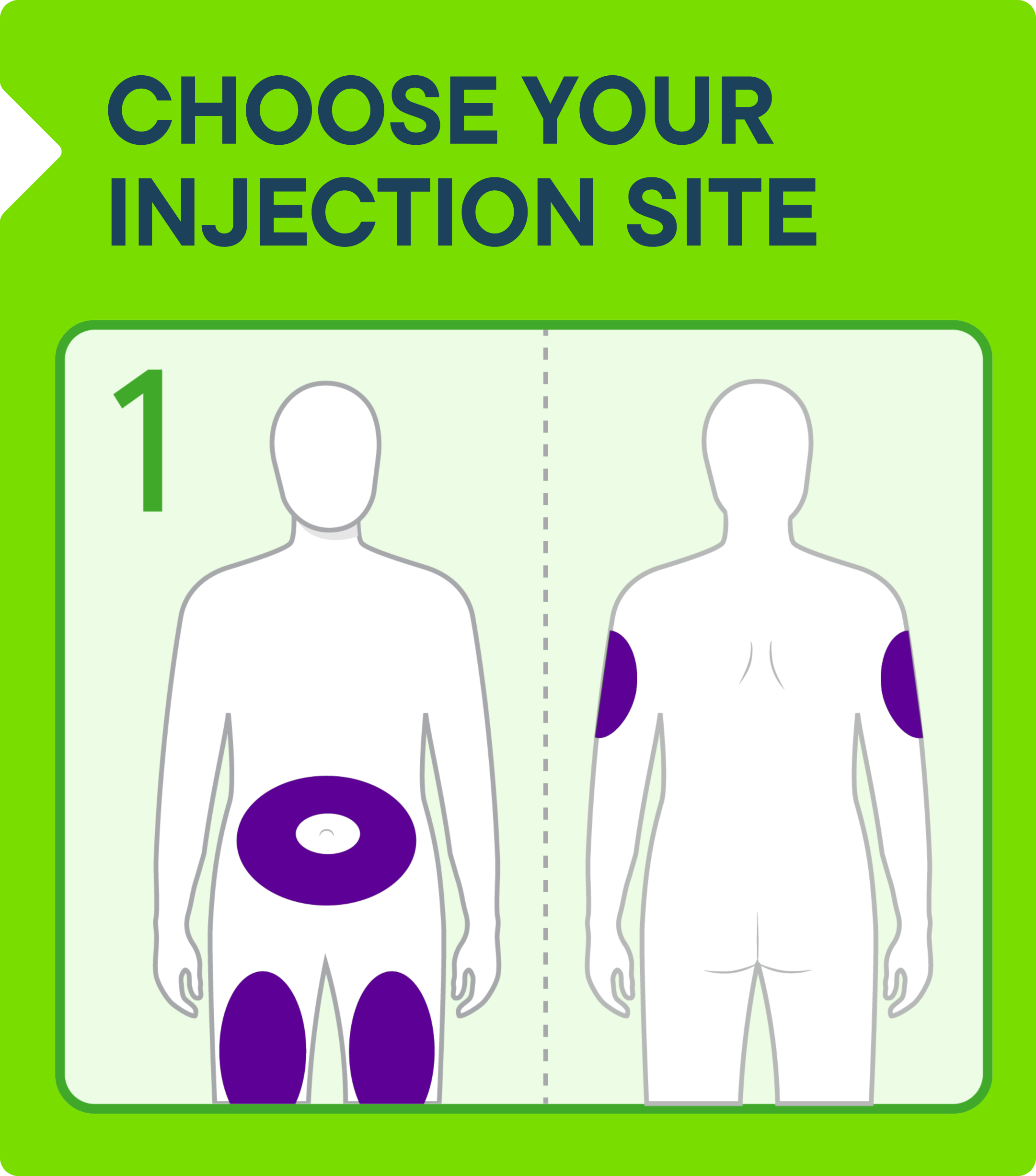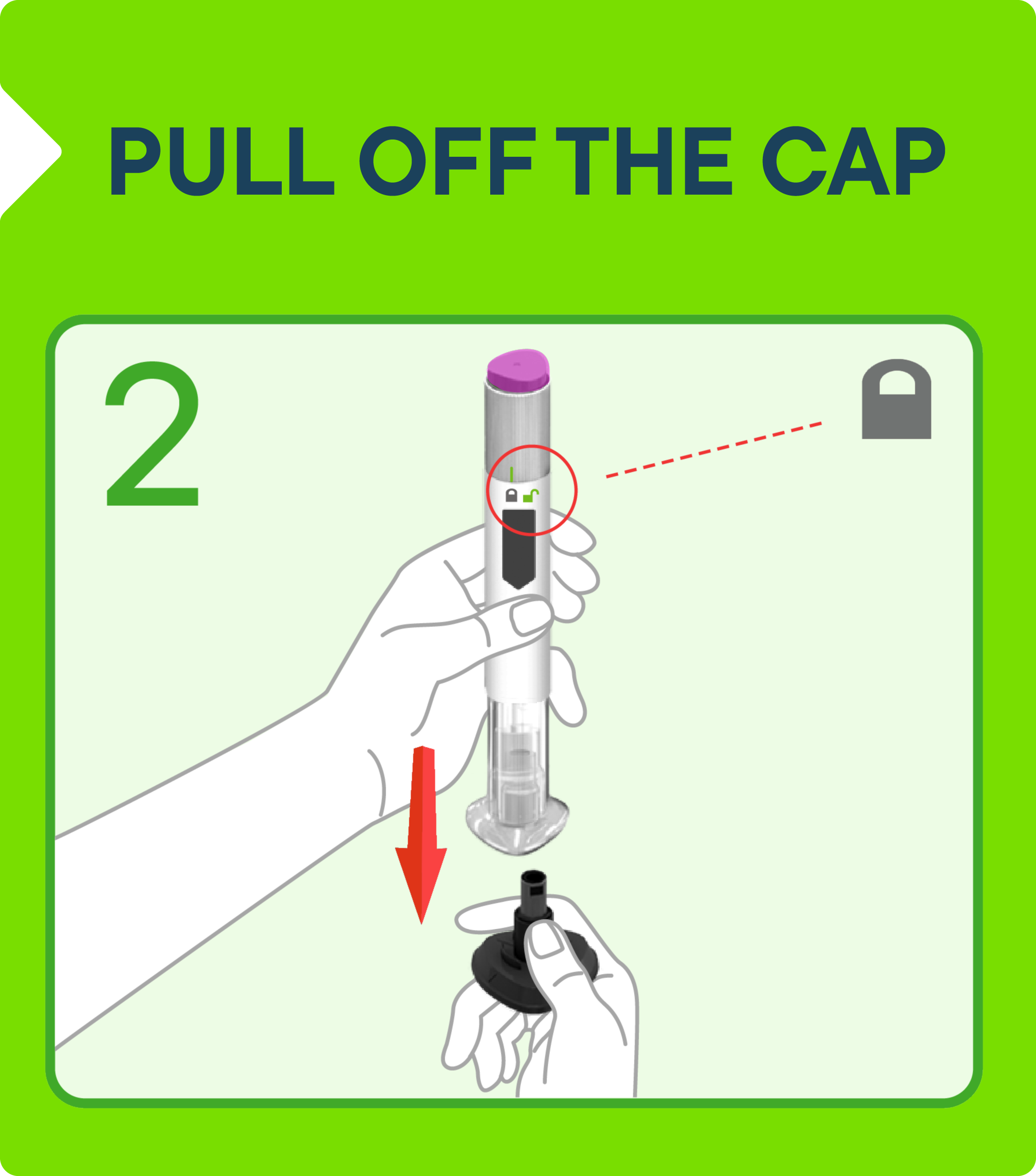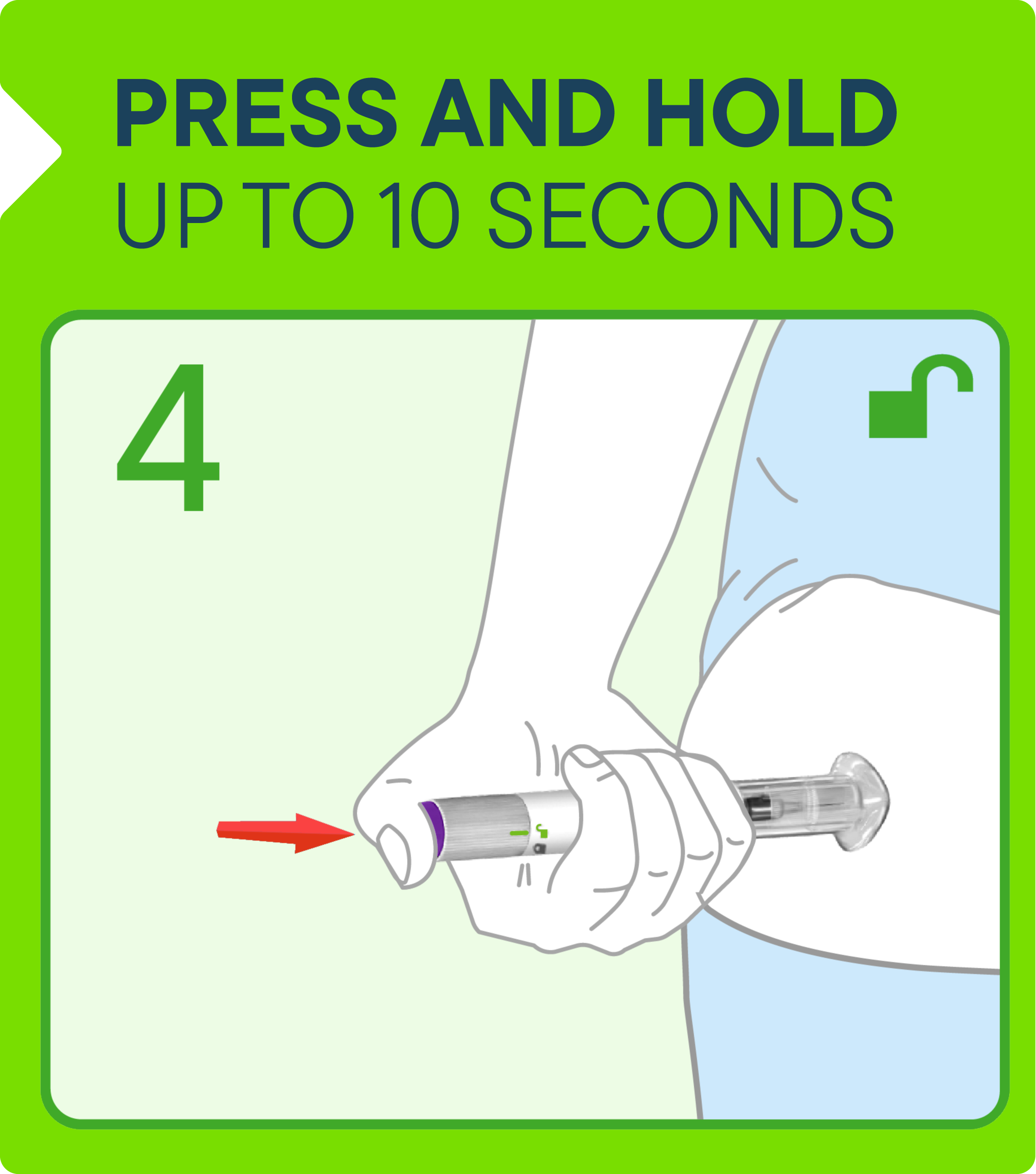
Once a week. Ready to use.
Your weekly Zepbound routine
Take Zepbound at home, with or without food, once a week
Zepbound comes in a single-dose pen that requires no mixing. There's no need to see or handle the needle.
Your healthcare provider can help you choose the injection site that is best for you. You or another person can inject the medicine in your stomach or thigh. Another person should give you the injection in the back of your upper arm.

Watch and learn: A step-by-step guide to your Zepbound pen
Please read the full Instructions for Use included with your Zepbound pen
00:00-00:42
[The Zepbound logo and title animate on screen, followed by the Indication and Limitations of Use.]
CAPTION: HOW TO USE once weekly Zepbound® (tirzepatide) injection 0.5 mL 2.5 mg | 5 mg | 7.5 mg | 10 mg | 12.5 mg | 15 mg
Indication and Limitations of Use (LOU)
NARRATOR: Indication and Limitations of Use (LOU). Zepbound is an injectable prescription medicine that may help adults with obesity, or with excess weight (overweight) who also have weight-related medical problems, lose weight and keep it off. Zepbound should be used with a reduced-calorie diet and increased physical activity.
Zepbound contains tirzepatide and should not be used with other tirzepatide-containing products or any GLP-1 receptor agonist medicines. It is not known if Zepbound is safe and effective when taken with other prescription, over-the-counter, or herbal weight loss products. It is not known if Zepbound can be used in people who have had pancreatitis. It is not known if Zepbound is safe and effective for use in children under 18 years of age.
00:42-01:18
[Select Safety Information animates on screen.]
CAPTION: HOW TO USE once weekly Zepbound™ (tirzepatide) injection 0.5 mL 2.5 mg | 5 mg | 7.5 mg | 10 mg | 12.5 mg | 15 mg
Select Safety Information
NARRATOR: Select Safety Information. Tell your healthcare provider if you get a lump or swelling in your neck, hoarseness, trouble swallowing, or shortness of breath. These may be symptoms of thyroid cancer. In studies with rats, Zepbound and medicines that work like Zepbound caused thyroid tumors, including thyroid cancer. It is not known if Zepbound will cause thyroid tumors, or a type of thyroid cancer called medullary thyroid carcinoma (MTC) in people. Do not take Zepbound if you or any of your family have ever had MTC or if you have an endocrine system condition called Multiple Endocrine Neoplasia syndrome type 2 (MEN 2).
01:18-01:23
CAPTION: HOW TO USE once weekly Zepbound™ (tirzepatide) injection 0.5 mL 2.5 mg | 5 mg | 7.5 mg | 10 mg | 12.5 mg | 15 mg
NARRATOR: See Indication and Safety Summary with Warnings at the end of this video.
01:23-01:34
[Title card fades to a woman named Andrea taking a selfie video with her phone as she walks into her living room. Upbeat music plays in the background. Andrea shows us the Zepbound box and sits comfortably on her couch.]
CAPTION: Actor portrayal throughout.
ANDREA: I just got back from the pharmacy and I bet you’re wondering what’s inside. Let’s open it together?
01:34-02:02
[The selfie screen expands to a full, wide screen as Andrea opens the Zepbound box. The box glows green, lighting up Andrea’s delighted face as she takes the Zepbound pen out of the box.]
CAPTION: 2.5 mg is the starting dose and not indicated for chronic weight management. After 4 weeks, dose should be increased to 5 mg once weekly.
Zepbound should be used along with a reduced-calorie meal plan and increased
physical activity. Individual results may vary.
ANDREA: This is the once-weekly, single-use Zepbound pen! You may already know that Zepbound is proven to help adults with obesity lose weight along with diet and exercise. So now let's take a look at how to use the pen. And if you're like me, you may be nervous to inject for the first time. But don't worry, I'm here to walk you through each step of using it.
02:02-02:08
[Andrea holds up the Zepbound pen and looks at a graphic that animates on screen]
CAPTION: Keep it in the refrigerator between 36ºF and 46ºF, not exposed to freezing temperatures
If Zepbound is stored at room temperature, it should not be returned to the
refrigerator.
ANDREA: To start, let's talk about how to store Zepbound. It is best to keep it in the refrigerator.
02:08-02:16
[New text animates on the graphic.]
CAPTION: Keep it in its original carton and away from direct light and heat (safe up to 86ºF)
If Zepbound is stored at room temperature, it should not be returned to the
refrigerator. Discard if not used within 21 days after removing from the refrigerator.
ANDREA: But if you're traveling and don't have access to a fridge, the pens can stay at room temperature for up to 21 days. Now, come take a closer look.
02:16-02:25
[In a close-up of the Zepbound pen in Andrea’s hand, a green graphic line traces and highlights the pen’s cap, then the 2.5 mg label.]
ANDREA: This gray cap stays on until you are ready to inject. Double check that the pen is not damaged and that you’re taking the correct medicine and dose.
02:25-02:33
[The close-up of the Zepbound pen in Andrea's hand remains on screen as a graphic animates on.]
CAPTION: Frozen Cloudy Discolored Particles Expired
ANDREA: Don’t use it if the medicine is frozen, cloudy, discolored, or has any particles. And be sure to check the expiration date.
02:33-02:55
[Back to a medium shot of Andrea holding the Zepbound pen on her couch as a new graphic highlighting parts of the body animates on screen.]
CAPTION: 1. CHOOSE YOUR INJECTION SITE
ANDREA: The first step is to decide where to inject. You can do it in your stomach or thighs by yourself, or in the back of your upper arms with someone’s help. You can use the same area every week, just don’t inject into the same exact spot. Your doctor can help you with these choices. I'm going for the stomach.
02:55-03:01
[A hand-washing icon graphic animates on screen.]
ANDREA: Oh, and make sure to wash your hands before every injection. Just three more steps left.
03:01-03:12
[Andrea stands up from the couch and walks to another part of her living room. She watches as a new graphic showing a hand pulling the cap from the Zepbound pen animates on. The screen then changes to another close-up of Andrea holding the Zepbound pen.]
CAPTION: 2. PULL OFF THE CAP
ANDREA: With the pen locked, remove the gray cap and throw it away. And do not touch the base.
03:12-03:20
[Andrea places the pen on her stomach and unlocks it as another graphic showing a person placing the Zepbound pen on their stomach animates on.]
CAPTION: 3. PLACE AND UNLOCK
ANDREA: Place the clear base of the pen flat against your skin and unlock it by turning the lock ring.
03:20-03:37
[The camera moves down and zooms in on Andrea’s stomach as she gives herself the injection. Another graphic showing a person pushing the button of the Zepbound pen animates on. The pen clicks. After 10 seconds, it clicks again. Andrea finishes the injection and holds the pen to the camera while a green graphic line traces and highlights the gray plunger.]
CAPTION: 4. PRESS AND HOLD UP TO 10 SECONDS
ANDREA: Press and hold the purple button for up to 10 seconds. The first click means the injection has started. Keep holding. The second click means it’s done. The injection is complete when the gray plunger is visible.
03:37-03:50
[Andrea holds the pen up. She then disposes of the pen in an FDA-cleared sharps container before she picks up her phone.]
ANDREA: And that's all! The process is the same regardless of the dose you've been prescribed. Now you just need to safely dispose of your used pen in an FDA-cleared sharps container.
03:50-04:17
[Still filming selfie style, Andrea sets her phone down on a cabinet in her laundry room. She steps back and picks up a laundry detergent bottle, gesturing toward different areas of the bottle as she speaks.]
ANDREA: If you don't have an FDA-cleared sharps container, you can use a heavy-duty plastic household container, such as a laundry detergent bottle. And no, this isn't a paid partnership with a detergent brand. Just make sure it’s made of heavy-duty plastic, has a tight-fitting, puncture-resistant lid, is leak-resistant, and is properly labeled.
04:17-04:43
[Suddenly, Andrea’s excited and clumsy dog joins her in the laundry room, bumping into the cabinet and causing the phone to fall to the floor. Andrea picks the phone up from the floor, smiles, and pets her dog as she speaks to the phone.]
ANDREA: Just make sure you leave it in a safe place away from kids and pets! I hope I’ve helped you feel comfortable with your Zepbound injection. But if you have more questions, talk to your doctor or visit Zepbound.com.
04:43-04:49
[The green Zepbound arrows fly in, wiping on a white title card as the Zepbound logo fades on.]
CAPTION: once weekly Zepbound™ (tirzepatide) injection 0.5 mL 2.5 mg | 5 mg | 7.5 mg | 10 mg | 12.5 mg | 15 mg
04:49-12:54
[The Zepbound logo fades out before Important Safety Information fades in and begins to scroll. Background music plays quietly.]
CAPTION: INDICATION AND SAFETY SUMMARY WITH WARNINGS
once weekly Zepbound™ (tirzepatide) injection 0.5 mL 2.5 mg | 5 mg | 7.5 mg | 10 mg | 12.5 mg | 15 mg
NARRATOR: INDICATION AND SAFETY SUMMARY WITH WARNINGS. Zepbound™ is an injectable prescription medicine that may help adults with obesity, or with excess weight (overweight) who also have weight-related medical problems, lose weight and keep it off. It should be used with a reduced-calorie diet and increased physical activity.
Zepbound contains tirzepatide and should not be used with other tirzepatide-containing products or any GLP-1 receptor agonist medicines. It is not known if Zepbound is safe and effective when taken with other prescription, over-the-counter, or herbal weight loss products. It is not known if Zepbound can be used in people who have had pancreatitis. It is not known if Zepbound is safe and effective for use in children under 18 years of age.
Warnings. Zepbound may cause tumors in the thyroid, including thyroid cancer. Watch for possible symptoms, such as a lump or swelling in the neck, hoarseness, trouble swallowing, or shortness of breath. If you have any of these symptoms, tell your healthcare provider.
Do not use Zepbound if you or any of your family have ever had a type of thyroid cancer called medullary thyroid carcinoma (MTC). Do not use Zepbound if you have Multiple Endocrine Neoplasia syndrome type 2 (MEN 2). Do not use Zepbound if you have had a serious allergic reaction to tirzepatide or any of the ingredients in Zepbound.
Zepbound may cause serious side effects, including:
Severe stomach problems. Stomach problems, sometimes severe, have been reported in people who use Zepbound. Tell your healthcare provider if you have stomach problems that are severe or will not go away.
Kidney problems (kidney failure). Diarrhea, nausea, and vomiting may cause a loss of fluids (dehydration), which may cause kidney problems. It is important for you to drink fluids to help reduce your chance of dehydration.
Gallbladder problems. Gallbladder problems have happened in some people who use Zepbound. Tell your healthcare provider right away if you get symptoms of gallbladder problems, which may include pain in your upper stomach (abdomen), fever, yellowing of skin or eyes (jaundice), or clay-colored stools.
Inflammation of the pancreas (pancreatitis). Stop using Zepbound and call your healthcare provider right away if you have severe pain in your stomach area (abdomen) that will not go away, with or without vomiting. You may feel the pain from your abdomen to your back.
Serious allergic reactions. Stop using Zepbound and get medical help right away if you have any symptoms of a serious allergic reaction, including swelling of your face, lips, tongue or throat, problems breathing or swallowing, severe rash or itching, fainting or feeling dizzy, or very rapid heartbeat.
Low blood sugar (hypoglycemia). Your risk for getting low blood sugar may be higher if you use Zepbound with medicines that can cause low blood sugar, such as a sulfonylurea or insulin. Signs and symptoms of low blood sugar may include dizziness or light-headedness, sweating, confusion or drowsiness, headache, blurred vision, slurred speech, shakiness, fast heartbeat, anxiety, irritability, mood changes, hunger, weakness or feeling jittery.
Changes in vision in patients with type 2 diabetes. Tell your healthcare provider if you have changes in vision during treatment with Zepbound.
Depression or thoughts of suicide. You should pay attention to changes in your mood, behaviors, feelings or thoughts. Call your healthcare provider right away if you have any mental changes that are new, worse, or worry you.
Common side effects. The most common side effects of Zepbound include nausea, diarrhea, vomiting, constipation, stomach (abdominal) pain, indigestion, injection site reactions, feeling tired, allergic reactions, belching, hair loss, and heartburn. These are not all the possible side effects of Zepbound. Talk to your healthcare provider about any side effect that bothers you or doesn’t go away.
Tell your healthcare provider if you have any side effects. You can report side effects at 1-800-FDA-1088 or www.fda.gov/medwatch.
Before using Zepbound. Your healthcare provider should show you how to use Zepbound before you use it for the first time. Tell your healthcare provider if you are taking medicines to treat diabetes including insulin or sulfonylureas which could increase your risk of low blood sugar. Talk to your healthcare provider about low blood sugar levels and how to manage them. If you take birth control pills by mouth, talk to your healthcare provider before you use Zepbound. Birth control pills may not work as well while using Zepbound. Your healthcare provider may recommend another type of birth control for 4 weeks after you start Zepbound and for 4 weeks after each increase in your dose of Zepbound.
Review these questions with your healthcare provider: Do you have other medical conditions, including problems with your pancreas or kidneys, or severe problems with your stomach, such as slowed emptying of your stomach (gastroparesis) or problems digesting food? Do you take diabetes medicines, such as insulin or sulfonylureas? Do you have a history of diabetic retinopathy? Do you take any other prescription medicines or over-the-counter drugs, vitamins, or herbal supplements? Are you pregnant, plan to become pregnant, breastfeeding, or plan to breastfeed? Zepbound may harm your unborn baby. Tell your healthcare provider if you become pregnant while using Zepbound. It is not known if Zepbound passes into your breast milk. You should talk with your healthcare provider about the best way to feed your baby while using Zepbound.
Pregnancy Exposure Registry: There will be a pregnancy exposure registry for women who have taken Zepbound during pregnancy. The purpose of this registry is to collect information about the health of you and your baby. Talk to your healthcare provider about how you can take part in this registry, or you may contact Lilly at 1-800-LillyRx (1-800-545-5979).
How to take. Read the Instructions for Use that come with Zepbound. Use Zepbound exactly as your healthcare provider says. Zepbound is injected under the skin (subcutaneously) of your stomach (abdomen), thigh, or upper arm. Use Zepbound 1 time each week, at any time of the day. Change (rotate) your injection site with each weekly injection. Do not use the same site for each injection. If you take too much Zepbound, call your healthcare provider, seek medical advice promptly, or contact a Poison Center expert right away at 1-800-222-1222.
Learn more. Zepbound is a prescription medicine. For more information, call 1-800-LillyRx (1-800-545-5979) or go to www.zepbound.lilly.com.
This summary provides basic information about Zepbound but does not include all information known about this medicine. Read the information that comes with your prescription each time your prescription is filled. This information does not take the place of talking with your healthcare provider. Be sure to talk to your healthcare provider about Zepbound and how to take it. Your healthcare provider is the best person to help you decide if Zepbound is right for you.
ZP CON CBS 08NOV2023
Zepbound™ and its delivery device base are trademarks owned or licensed by Eli Lilly and Company, its subsidiaries, or affiliates.
12:54-12:56
[The Zepbound logo fades back in.]
CAPTION: once weekly Zepbound™ (tirzepatide) injection 0.5 mL 2.5 mg | 5 mg | 7.5 mg | 10 mg | 12.5 mg | 15 mg
A Lilly Medicine
visit www.zepbound.lilly.com or call 1-800-LillyRX for pricing information
12:56-12:58
[The Lilly logo animates on, covering the screen in red as the background music fades out.]
CAPTION: Lilly A MEDICINE COMPANY
After you inspect your pen, follow these 4 steps to use Zepbound
You don't have to mix Zepbound. And you don't have to see the needle. Follow the below steps to use your Zepbound pen*:
Even if you don't feel a poke, if you hear 2 clicks, the injection is complete. You will know your injection is complete when the gray plunger is visible.
*These 4 steps are not the complete instructions for using Zepbound. Before starting Zepbound, your healthcare provider should show you how to use the Zepbound pen. Always inspect your pen prior to injection and read the full Instructions for Use included with your Zepbound pen or watch how to use the Zepbound pen at www.zepbound.lilly.com.
†Your healthcare provider can help you choose the injection site that is best for you. You or another person can inject the medicine in your stomach or thigh. Another person should give you the injection in the back of your upper arm.
Pro tip: Set a reminder on your phone so you don't forget when to take Zepbound
Protect your pens
How to store your Zepbound pens
- Store your pen in the refrigerator between 36°F to 46°F (2°C to 8°C).
- You may store your pen at room temperature up to 86°F (30°C) for up to 21 days. If you store the pen at room temperature, do not return the pen to the refrigerator.
- Discard the pen if not used within 21 days after removing from the refrigerator.
- Do not freeze your pen. If the pen has been frozen, throw the pen away and use a new pen.
- Store your pen in the original carton to protect your pen from light.
- The pen has glass parts. Handle it carefully. If you drop the pen on a hard surface, do not use it. Use a new pen for your injection.
- Keep your Zepbound pen and all medicines out of the reach of children.
Take Zepbound with you
You should store your pen in the refrigerator between 36°F to 46°F (2°C to 8°C). If unable to, you may store your pen at room temperature up to 86°F (30°C) for up to 21 days. If you store the pen at room temperature, do not return the pen to the refrigerator.
- Discard the pen if not used within 21 days after removing from the refrigerator.
- Store your pen in the original carton to protect your pen from light.
One last step
Properly dispose of your used Zepbound pens
It is important to dispose of your used pen safely. To do this, put your used pen in an FDA-cleared sharps disposal container right away after use. Do not throw away pens in household trash. If you don't have an FDA-cleared sharps container, use a household container. Make sure it is made of heavy-duty plastic, can be closed with a tight-fitting, puncture-resistant lid, and it is upright, stable, leak-resistant, and properly labeled to warn of hazardous waste.
Keep the container out of the reach of children. Do not recycle your sharps container. Follow your community guidelines for the right way to dispose of your sharps disposal container.
Safe sharps containers:
-
FDA-cleared sharps container

-
Detergent bottles‡
‡Make sure these bottles are cleaned, emptied, and labeled before use.
Find the dose that’s right for you
With multiple options, you and your doctor can work together to find the once-weekly dose of Zepbound that fits your body's changing needs.
Zepbound dosing has to be increased gradually over time
You’ll begin treatment at a recommended 2.5 mg starting dose.§ After 4 weeks, your doctor will increase your dose to 5 mg. After another 4 weeks, your doctor may keep you at the 5-mg dose or, if needed, increase the dosage in 2.5 mg increments after at least 4 weeks on the current dose.ǁ
Keep up with your plan: You’ll work with your doctor to follow this step-by-step dosing process to see what dose works best for you.
§2.5 mg is the starting dose and not indicated for chronic weight management. After 4 weeks, dose should be increased to 5 mg once weekly. The recommended maintenance doses are 5 mg, 10 mg or 15 mg.
ǁThe maximum dosage is 15 mg subcutaneously once weekly.

The starting dose is 2.5 mg once weekly. After 4 weeks, dose will be increased to 5 mg. Your dose can be increased in 2.5 mg increments after at least 4 weeks on the current dose. The maximum dosage is 15 mg once weekly.
Managing possible side effects
Talk to your doctor if you have any side effects that bother you or don't go away.
Everyone can have a different experience, but the most common side effects reported by people taking Zepbound were:
- Nausea
- Diarrhea
- Vomiting
- Constipation
- Stomach (abdominal) pain
- Indigestion
- Injection site reactions
- Fatigue
- Allergic reactions
- Belching
- Hair loss
- Heartburn
Side effects over time
In studies, most nausea, diarrhea, and vomiting occurred when people increased their dose—but the effects generally decreased over time.
In studies, gastrointestinal (GI) side effects were more common in people taking Zepbound than people taking placebo, and people taking Zepbound were more likely to stop treatment because of these side effects.
Select Safety Information
Zepbound can cause serious side effects, including:
Severe stomach problems. Stomach problems, sometimes severe, have been reported in people who use Zepbound. Tell your healthcare provider if you have stomach problems that are severe or will not go away.
Kidney problems (kidney failure). Diarrhea, nausea, and vomiting may cause a loss of fluids (dehydration), which may cause kidney problems. It is important for you to drink fluids to help reduce your chance of dehydration.
See tips below for help with managing nausea.
Tips that may help with nausea
If you experience nausea, talk to your doctor. In the meantime, it may help to:
-
Eat smaller meals—try splitting 3 daily meals into 4 or more smaller ones
-
Stop eating when you feel full
-
Avoid fatty foods like butter or cheese
-
Try eating bland foods like toast, crackers, or rice





